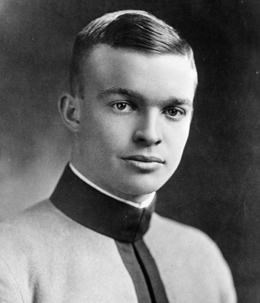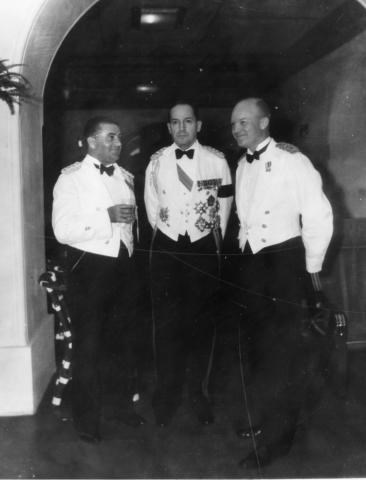Last updated: November 8, 2022
Article
General Dwight David Eisenhower’s Military Career Outside WWI and WWII

Courtesy of the Eisenhower Presidential Library
General Eisenhower was well known for his extraordinary military career during World War II. During the war, he rose to the lofty position of Supreme Allied Commander despite never enduring the horrors of fighting in World War I. To many historians, this lack of combat experience during World War I was an advantage to General Eisenhower because his strategic and tactical mindset was not trapped in the horrors of trench warfare.
Although General Eisenhower did not serve in combat during WWI, his service as the commanding officer of the U.S. Army Tank Corp at Camp Colt in Gettysburg, PA. was exceptional. He performed way beyond his rank and developed the skills of administration, management, logistics, organization, training, and most importantly leadership that aided him during the next world war.
Outside of General Eisenhower’s service during the World Wars, most people know very little of his military career. This time of his army life with painfully slow advancement in rank developed Eisenhower into the great leader of armies.

Courtesy of the Eisenhower Presidential Library
Eisenhower’s first assignment after he graduated from the U.S. Military Academy at West Point NY in 1915 was Fort Sam Houston in San Antonio, TX. He met his wife, Mamie Geneva Doud, while stationed in San Antonio. Mamie’s family spent the winter in Texas.He requested orders to serve in the Pancho Villa Punitive Expedition into Mexico in 1916, but he instead had to settle with training and supplying National Guard Troops on border patrol duty. After a few more training assignments in the early days of WWI, he was ordered to the Tank Corp at Fort Meade, MD. Shortly, he was ordered to establish the Tank Corp camp in Gettysburg.
Following the war, Eisenhower returned to Fort Meade. He quickly became friends with George S. Patton who had served in the Tank Corps in France. Patton introduced Eisenhower to Major General Fox Conner, who was regarded as an intellectual general and a great mentor. Eisenhower served as Conner's assistant in the Panama Canal Zone for several years. General Conner put Eisenhower through a “…graduate school in military history.” He learned to think critically and look at the big picture.With Conner’s help, Eisenhower was admitted to the Command and General Staff School at Fort Leavenworth. Using the intellectual skills that he had developed under Conner, Eisenhower finished number one in his class. He continued to expand his education at the Army War College in Washington D.C.
After his schooling, Eisenhower received orders to serve under General John “Black Jack” Pershing of WWI fame at the American Battle Monuments Commission. Eisenhower and his family spent a year in Western Europe studying and researching the battlefields of the Great War for him to write a lengthy guidebook. This experience in the geography and cultures of Europe greatly aided Eisenhower in WWII.

Courtesy of the Eisenhower Presidential Library
Once he was back in the United States, Eisenhower entered the War Department as a Staff Officer working on preparedness and mobilization of civilian industries to wartime production. In the War Department, he gained the reputation as a talented writer and was requested by the Chief of Staff of the Army, General Douglas MacArthur, to write his reports. In 1933, General MacArthur made Eisenhower his principal assistant. Two years later, General MacArthur was appointed the Military Advisor to the new Philippine Commonwealth. He pressured Eisenhower to transfer with him. Eisenhower served superbly for MacArthur in developing a military for the commonwealth despite the lack of resources.
After four years in the Philippines, Eisenhower returned the United States. A war was raging in Europe and the neutral United States was drafting soldiers and expanding its military. Eisenhower’s skills and talent rapidly propelled him from an Executive Officer of a Regiment, to a Chief of Staff of a Division, to a Chief of Staff of a Corps, to a Chief of Staff of an Army in less than a year and half. His performance at the Louisiana Maneuvers in August and September 1941 earned him significant praise, notoriety, and a promotion to Brigadier General.
Five days after the December 7, 1941 Japanese attack on Pearl Harbor, Hawaii, Eisenhower was summoned to the War Department by Chief of Staff George C. Marshall. The Philippines and the Far East was a crisis. Marshall wanted an officer with the knowledge of the Philippines. Eisenhower passed the interview test with General Marshall and was made the War Planner for the Philippines and the Far East. This assignment commenced Eisenhower’s meteoric rise in World War II.After World War II, in November 1945, General Marshall retired from the United States Army. General Eisenhower was appointed by President Harry Truman as the new Chief of Staff. Since the post war army was being rapidly demobilized, this was a challenging and difficult time for Eisenhower. The United States had forgotten the lessons of World War I.
Eisenhower retired from the Army in January 1948 to write his memoirs and become the president of Columbia University.Soon after, he and Mamie would buy a 189-acre farm in Gettysburg, PA, with an eye towards retirement. Once again, however, history had other things in store for the Eisenhowers.
